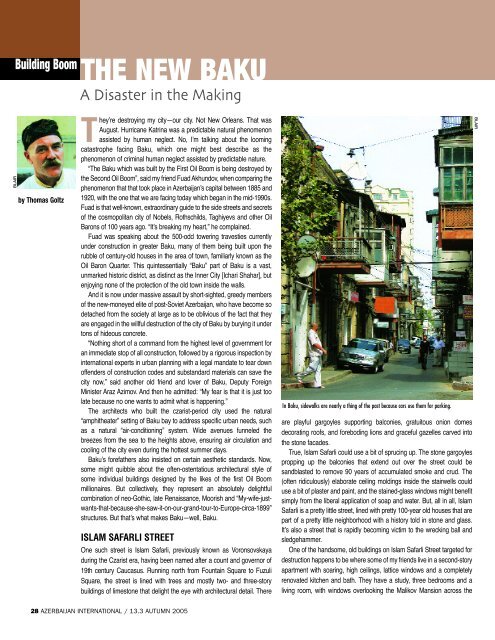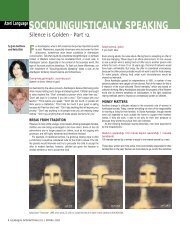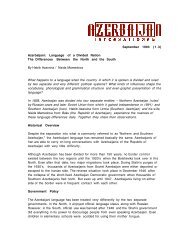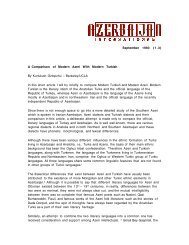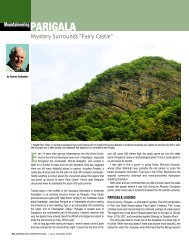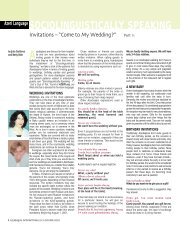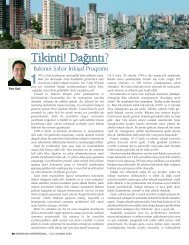PDF - 608 K, 4 pages - Azerbaijan International Magazine
PDF - 608 K, 4 pages - Azerbaijan International Magazine
PDF - 608 K, 4 pages - Azerbaijan International Magazine
Create successful ePaper yourself
Turn your PDF publications into a flip-book with our unique Google optimized e-Paper software.
BLAIR<br />
Building Boom THE NEW BAKU<br />
by Thomas Goltz<br />
A Disaster in the Making<br />
They’re destroying my city—our city. Not New Orleans. That was<br />
August. Hurricane Katrina was a predictable natural phenomenon<br />
assisted by human neglect. No, I’m talking about the looming<br />
catastrophe facing Baku, which one might best describe as the<br />
phenomenon of criminal human neglect assisted by predictable nature.<br />
“The Baku which was built by the First Oil Boom is being destroyed by<br />
the Second Oil Boom”, said my friend Fuad Akhundov, when comparing the<br />
phenomenon that that took place in <strong>Azerbaijan</strong>’s capital between 1885 and<br />
1920, with the one that we are facing today which began in the mid-1990s.<br />
Fuad is that well-known, extraordinary guide to the side streets and secrets<br />
of the cosmopolitan city of Nobels, Rothschilds, Taghiyevs and other Oil<br />
Barons of 100 years ago. “It’s breaking my heart,” he complained.<br />
Fuad was speaking about the 500-odd towering travesties currently<br />
under construction in greater Baku, many of them being built upon the<br />
rubble of century-old houses in the area of town, familiarly known as the<br />
Oil Baron Quarter. This quintessentially “Baku” part of Baku is a vast,<br />
unmarked historic district, as distinct as the Inner City [Ichari Shahar], but<br />
enjoying none of the protection of the old town inside the walls.<br />
And it is now under massive assault by short-sighted, greedy members<br />
of the new-moneyed elite of post-Soviet <strong>Azerbaijan</strong>, who have become so<br />
detached from the society at large as to be oblivious of the fact that they<br />
are engaged in the willful destruction of the city of Baku by burying it under<br />
tons of hideous concrete.<br />
“Nothing short of a command from the highest level of government for<br />
an immediate stop of all construction, followed by a rigorous inspection by<br />
international experts in urban planning with a legal mandate to tear down<br />
offenders of construction codes and substandard materials can save the<br />
city now,” said another old friend and lover of Baku, Deputy Foreign<br />
Minister Araz Azimov. And then he admitted: “My fear is that it is just too<br />
late because no one wants to admit what is happening.”<br />
The architects who built the czarist-period city used the natural<br />
“amphitheater” setting of Baku bay to address specific urban needs, such<br />
as a natural “air-conditioning” system. Wide avenues funneled the<br />
breezes from the sea to the heights above, ensuring air circulation and<br />
cooling of the city even during the hottest summer days.<br />
Baku’s forefathers also insisted on certain aesthetic standards. Now,<br />
some might quibble about the often-ostentatious architectural style of<br />
some individual buildings designed by the likes of the first Oil Boom<br />
millionaires. But collectively, they represent an absolutely delightful<br />
combination of neo-Gothic, late Renaissance, Moorish and “My-wife-justwants-that-because-she-saw-it-on-our-grand-tour-to-Europe-circa-1899”<br />
structures. But that’s what makes Baku—well, Baku.<br />
ISLAM SAFARLI STREET<br />
One such street is Islam Safarli, previously known as Voronsovskaya<br />
during the Czarist era, having been named after a count and governor of<br />
19th century Caucasus. Running north from Fountain Square to Fuzuli<br />
Square, the street is lined with trees and mostly two- and three-story<br />
buildings of limestone that delight the eye with architectural detail. There<br />
28 AZERBAIJAN INTERNATIONAL / 13.3 AUTUMN 2005<br />
In Baku, sidewalks are nearly a thing of the past because cars use them for parking.<br />
are playful gargoyles supporting balconies, gratuitous onion domes<br />
decorating roofs, and foreboding lions and graceful gazelles carved into<br />
the stone facades.<br />
True, Islam Safarli could use a bit of sprucing up. The stone gargoyles<br />
propping up the balconies that extend out over the street could be<br />
sandblasted to remove 90 years of accumulated smoke and crud. The<br />
(often ridiculously) elaborate ceiling moldings inside the stairwells could<br />
use a bit of plaster and paint, and the stained-glass windows might benefit<br />
simply from the liberal application of soap and water. But, all in all, Islam<br />
Safarli is a pretty little street, lined with pretty 100-year old houses that are<br />
part of a pretty little neighborhood with a history told in stone and glass.<br />
It’s also a street that is rapidly becoming victim to the wrecking ball and<br />
sledgehammer.<br />
One of the handsome, old buildings on Islam Safarli Street targeted for<br />
destruction happens to be where some of my friends live in a second-story<br />
apartment with soaring, high ceilings, lattice windows and a completely<br />
renovated kitchen and bath. They have a study, three bedrooms and a<br />
living room, with windows overlooking the Malikov Mansion across the<br />
BLAIR
street. Additional light comes in from a bank of<br />
windows overlooking the central courtyard shared by<br />
the three other traditional buildings on the block.<br />
It’s a very pleasant, airy apartment, and cost my<br />
friends a substantial amount when they bought it three<br />
years ago. I mention the price because I want to stress<br />
that it is not some dump or romantic tenement. Nor are<br />
my friends without resources. He is an expatriate<br />
employed in the oil sector; and she, a local lass, who<br />
has two businesses of her own. And yet they are so<br />
worried about what might happen to them if I used their<br />
real names that they have insisted on anonymity. To<br />
say they are afraid would be an exaggeration; but not<br />
to mention their concern would be to skirt the element<br />
of nastiness that pervades the current building boom.<br />
So let’s just call them “Hans” and “Seva”.<br />
“The only thing we’ve been able to find out about<br />
our enemy is its name—Park Company,” Hans<br />
explained as we sat in his pleasant, designer kitchen<br />
on a recent autumn Sunday. Outside, the drone of a<br />
cement truck meant that more liquid rock was being<br />
pumped into the frames of the monstrosity that are<br />
literally enveloping their home. “When they started the<br />
demolition of the building next door to clear way for<br />
their foundation, we went to the municipality to find out<br />
what was going on.”<br />
What was happening was the piece-meal purchase,<br />
apartment by apartment, of all the residences in the<br />
quadrant of which Hans’ and Seva’s apartment made<br />
up a quarter. Once Park Company owned an entire<br />
structure; the 100-year old buildings were pulled down.<br />
Thus began a summer of dust, noise, despair and<br />
outrage as the mysterious Park Company began<br />
building a 14-story high-rise monstrosity, with each<br />
additional floor encroaching further and further into the<br />
“air space” represented by the courtyard shared by all.<br />
If this wasn’t bad enough, the very proximity of the<br />
construction zone outside his kitchen window enabled<br />
Hans to study the incredibly shoddy building methods<br />
employed by the workers of Park Company.<br />
CRACKS IN THE CONCRETE<br />
“I work with cement; it’s my job,” spat an exasperated<br />
Hans. “And without conducting a thorough, chemical<br />
testing of the concrete, I don’t very, very low. But what<br />
is truly insane is that they have been pouring it in the<br />
middle of one of the hottest summers in <strong>Azerbaijan</strong>i<br />
history—40 degrees! [more than 100 degrees<br />
Fahrenheit]—and without even bothering to splash on<br />
water during the drying process before slapping up the<br />
next level. That’s a guaranteed recipe for disaster.”<br />
AZER.COM<br />
Within weeks, cracks began to appear in the<br />
foundation of the new building—and Hans and Seva<br />
decided to sue Park Company through their insurance<br />
company for flagrant building code violations. But as<br />
concrete floor after concrete floor rose above their<br />
kitchen window, my friends were unable to find out any<br />
information about the construction company other than<br />
vague and veiled references to its owners being “very<br />
well connected” and not the type of folks to fool around with.<br />
“Everyone is afraid,” Seva told me. “They’re either<br />
afraid of the consequences of talking, or afraid of not<br />
being able to sell their apartments to the developers if<br />
there is a stink. I’m not sure which is worse.”<br />
Finally, Seva called in the local media to make a<br />
stand—only to be informed that the television station<br />
was not interested in investigating the story as long as<br />
Park Company was part of the picture.<br />
“The only thing we can hope for at this point is to<br />
make a windfall profit by being the last legal residents<br />
in the quadrant, and forcing them to buy us out at a<br />
maximum price,” said Hans. “That might sound good<br />
to some people, but the fact of the matter is that we are<br />
being forced out of our home.”<br />
That was mid-August.<br />
By mid-September, Seva had finally discovered<br />
who was the money behind Park Company: suffice it<br />
to say that it is one of the “untouchables”—an<br />
individual of wealth and influence. Here is a recent<br />
email from Seva expressing her despair:<br />
NO RECOURSE<br />
“Thomas, it’s getting worse and worse. Some<br />
months ago, I made my claim at the (ABC) District<br />
Court. They were supposed to answer me within two<br />
weeks (according to law), but the judge sat on it for<br />
one month and made the decision to send it to another<br />
court—this time in the (XYZ) district. But the judge<br />
there is afraid of the case and doesn’t want to take it.<br />
“Then today Park Company wrote a letter to the<br />
court refusing to have the case heard in the (XYZ)<br />
District because the apartment building is really in the<br />
(ABC) District.<br />
“But you see, they’re doing this deliberately to stall<br />
for time so that they can finish construction prior to<br />
Top: Ornate monogram “M” atop the elegant Malikov residence on<br />
Islam Safarli Street. This building, like most original residences on this<br />
street, dates back to Baku’s Oil Baron period (about 1880-1920).<br />
Today many such elegant buildings are being demolished and replaced<br />
with 15-25 story towers.<br />
Right: Many of Baku’s streets in the center of town are so narrow that<br />
only two cars can pass. And yet towers are being built with no facilities<br />
for parking.<br />
13.3 AUTUMN 2005 / AZERBAIJAN INTERNATIONAL 29<br />
BLAIR THOMAS GOLTZ
Building Boom<br />
PIROUZ KHANLOU<br />
Above: The new skyline in downtown Baku: more than 500 towers have been constructed since 2000.<br />
Right: Many of Baku’s old buildings of two and three stories which date from the Oil Baron period (1880-1920) are being replaced with poorly designed towers of strange eclectic architectural styles.<br />
elections [Parliament elections on November 6, 2005]. They’re building<br />
like crazy now; sometimes they complete an entire floor in a single day.<br />
We can’t sleep at nights because of the noise. Now the Appellate Court<br />
has to decide whether the case will be handled in the (ABC) district or the<br />
(XYZ) district. That decision could take up to another two months.<br />
“I want to hold a press conference with my lawyer and, if possible, get<br />
my insurance company involved, too. If you would be here, you could help<br />
me. You’re a professional. I don’t know what to do, I’m completely lost.<br />
“So, Thomas, this government does everything to make people go<br />
against them. If someone is their friend, he doesn’t have to pay attention<br />
to the law or the Constitution, he can do whatever he wants. He is king.”<br />
Hans and Seva’s dilemma is not unique. Up and down Islam Safarli<br />
and most other byways in the historical Oil Baron town, Park Company<br />
and its ilk are buying up family homes for flash cash, destroying the<br />
neighborhoods, and gutting the one- and two-story buildings they<br />
acquire without reference to anything remotely resembling a growth<br />
policy plan.<br />
Cement trucks clog the narrow streets as they fill in shallow foundations<br />
for new sky scrappers—morning, noon and night. The happy workers are<br />
paid between $10 and $20 per day, depending on their tasks, and without<br />
access to any sort of safety equipment. All of those interviewed in the<br />
course of this investigation declined to give their full names, lest they be<br />
fired. But all of them agreed: none would ever have enough money to live<br />
in the monstrous structures. Which brings up the obvious question: for<br />
whom are these new buildings being built? One price quoted is that a<br />
30 AZERBAIJAN INTERNATIONAL / 13.3 AUTUMN 2005<br />
square meter now costs $3,000, which translates to something on the<br />
order of a million dollars for a flat the size that my friends Hans and Seva<br />
currently live in. Who, aside from the elite few, has that sort of money or<br />
access to a mortgage?<br />
And as for monthly rental fees, I was quoted a cool $1,300 for a onebedroom<br />
apartment on the fourth floor in a soulless, 20-floor structure<br />
slapped up on Fuzuli Street. Which young professional <strong>Azerbaijan</strong>i can<br />
afford such a monthly fee? As for the foreign market, the corporate types<br />
are already ensconced in gated communities, and the idea that the<br />
apartments can be sold as an “investment” can be dismissed as<br />
ridiculous. With so many “brand new” units going up, who in their right<br />
mind would even think of buying a second-rate apartment that is already<br />
falling apart, even if they had the money?<br />
More likely, confidential sources in law enforcement tell me, many of<br />
the new structures are being built less for the lure of profit than as a means<br />
of “laundering” black money acquired through corrupt business practices,<br />
easy oil and possibly even narco-trafficking.<br />
The most damning—indeed, the most criminal—aspect of the new<br />
building boom, however, is the fact that many of the structures thrown up,<br />
night and day, are being built of substandard concrete, thanks to the<br />
admixture of seashore sand that contains corrosive salts. Whole beaches<br />
along the Absheron Peninsula have now become quarries exploited by<br />
contractors more interested in quick profits than the long-term structural<br />
integrity of the buildings (or the people living inside them).<br />
And as for reinforcement rods, a best-left nameless friend of mine
informed me that the contractors only use high-stress<br />
steel produced in Ukraine for the first six or eight<br />
stories, and then switch to cheaper, locally produced<br />
steel for the upper stories. I shudder to think what the<br />
next minor earthquake will do—no pun intended.<br />
INADEQUATE INFRASTRUCTURE<br />
And even if the new buildings do not fall down like a<br />
house of cards, life within the new towers will not be<br />
very pretty. How will the power grid handle thousands<br />
of juice-sucking air-conditioners and elevators? Even<br />
now the city’s water pumps are on their last legs. And<br />
whether there will be sufficient water for dishwashers,<br />
washing machines and showers is an unanswered<br />
question. And what about the impact on the sewage<br />
system when 10,000 new toilets all flush at once?<br />
Meanwhile, out on the streets, heat and smog will<br />
increase exponentially. The sheer number of new<br />
apartments will triple or quadruple the number of<br />
residents, and will thus invite double or triple the number<br />
of cars to squeeze into the narrow streets that were<br />
designed for pedestrians or horse-drawn carriages. The<br />
streets are already clogged, due to the surge in<br />
automobile ownership over the past few years.<br />
Sidewalks are already almost a thing of the past.<br />
So where does it all lead? And where and when<br />
does it all end?<br />
AZER.COM<br />
In a recent Open Letter to First Lady Mehriban<br />
Aliyeva, in essence, pleading for her intervention,<br />
<strong>Azerbaijan</strong>i journalist Sultan Sultanoghlu took issue by<br />
liberally (and quite appropriately) quoting Karl Marx:<br />
“‘Capital is happy with a 20-percent return, delighted<br />
with a 50-percent return, ecstatic with a 100-percent<br />
return, delirious with a 200-percent return. And with a<br />
300-percent return, Capital becomes insane. And the<br />
return rate in the building boom in Baku is 300 percent.’<br />
Something must be done before it is too late.”<br />
According to a good friend of mine who has friends<br />
investing in the construction craze, the numbers<br />
quoted above are not even true. “In two years, my<br />
friends hope to make a $50 million profit on a $3 million<br />
investment,” my source wrote. “It’s a chance of a<br />
lifetime!”<br />
But at what cost!<br />
Stop!<br />
Thomas Goltz, who lives in Montana, is the author of<br />
“<strong>Azerbaijan</strong> Diary” (M.E. Sharpe 1998/99) and “Chechnya<br />
Diary: A War Correspondent’s Story of Surviving the<br />
War in Chechnya” (St Martin’s Press, 2003). A new<br />
book about Georgia is scheduled for 2006 (M.E.<br />
Sharpe). This will be Goltz’ third book related to Post-<br />
Soviet ethnic conflicts in the Caucasus. ■<br />
Search AZER.com<br />
1. “Construction! Destruction? Blueprint for Baku’s Urban<br />
Development” by Pirouz Khanlou. AI 13.3 (Autumn 2005).<br />
2. “UNESCO: Baku’s Old City Listed as World Heritage Site”. AI 8.4<br />
(Winter 2000).<br />
3. “Architecture of the Oil Baron Period”. Introduction by Betty<br />
Blair. Building descriptions by Fuad Akhundov, Shamil Fatullayev,<br />
Fakhreddin Miralayev and Jala Garibova, AI 6.4 (Winter 1998).<br />
4. Entire issue of <strong>Azerbaijan</strong> <strong>International</strong>: “Glimpse of Glory:<br />
Inside Oil Baron Mansions”. AI 13.2 (Summer 2005).<br />
5. “Baku’s Metro Accident: A Challenge to Strategize by Elizabeth<br />
Atwell and Pirouz Khanlou”. AI 3.4 (Winter 1995).<br />
Other articles by and about Thomas Goltz in <strong>Azerbaijan</strong><br />
<strong>International</strong><br />
6. “Khojali Massacre: Eyewitness Account on the Following Day”<br />
(1992). AI 10.1 (Spring 2002).<br />
7. “Khojali: A Decade of Useless War Remembered”. AI 10.1<br />
(Spring 2002).<br />
8. “X-O-C-A-L-I: How to Spell Khojali”. AI 10.1 (Spring 2002).<br />
9. “Khojali—13 Years Later. Remember, But Be Sure to Preserve<br />
Your Souls”. AI 13.1 (Spring 2005).<br />
10. “Facts About Khojali”. AI 13.1 (Spring 2005).<br />
11. “Oil Odyssey” describing the group journey made three times<br />
between 2000 and 2002 via motorcycles and side cars for the<br />
entire length of the 1,100 mile pipeline route between Baku<br />
(<strong>Azerbaijan</strong>), Tbilisi (Georgia), and Ceyhan (Turkey). Search at<br />
AZER.com.<br />
12. “What’s New in Print about <strong>Azerbaijan</strong>: Chechnya Diary” by<br />
Thomas Goltz. AI 11.3 (Autumn 2003).<br />
13.3 AUTUMN 2005 / AZERBAIJAN INTERNATIONAL 31


